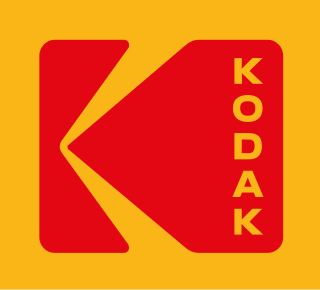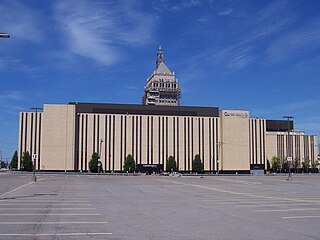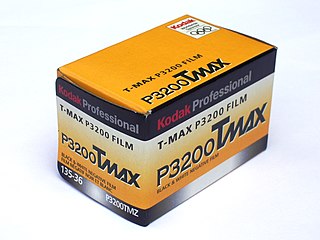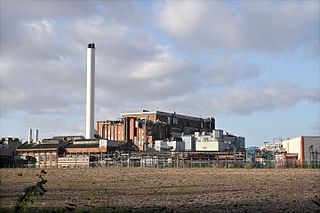
The Eastman Kodak Company, referred to simply as Kodak, is an American public company that produces various products related to its historic basis in film photography. The company is headquartered in Rochester, New York, and is incorporated in New Jersey. It is best known for photographic film products, which it brought to a mass market for the first time.

George Eastman was an American entrepreneur who founded the Eastman Kodak Company and helped to bring the photographic use of roll film into the mainstream. After a decade of experiments in photography, he patented and sold a roll film camera, making amateur photography accessible to the general public for the first time. Working as the treasurer and later president of Kodak, he oversaw the expansion of the company and the film industry.

Kodachrome is the brand name for a color reversal film introduced by Eastman Kodak in 1935. It was one of the first successful color materials and was used for both cinematography and still photography. For many years, Kodachrome was widely used for professional color photography, especially for images intended for publication in print media.

In photography, reversal film or slide film is a type of photographic film that produces a positive image on a transparent base. Instead of negatives and prints, reversal film is processed to produce transparencies or diapositives. Reversal film is produced in various sizes, from 35 mm to roll film to 8×10 inch sheet film.
The Cineon System was one of the first computer based digital film systems, created by Kodak in the early 1990s. It was an integrated suite of components consisting a Motion picture film scanner, a film recorder and workstation hardware with software for compositing, visual effects, image restoration and color management.

Ektachrome is a brand name owned by Kodak for a range of transparency, still and motion picture films previously available in many formats, including 35 mm and sheet sizes to 11 × 14 inch size. Ektachrome has a distinctive look that became familiar to many readers of National Geographic, which used it extensively for color photographs for decades in settings where Kodachrome was too slow. In terms of reciprocity characteristics, Ektachrome is stable at shutter speeds between ten seconds and 1/10,000 of a second.
The E-4 process is a now outdated process for developing color reversal (transparency) photographic film, which was introduced in 1966.

Ansco was the brand name of a photographic company based in Binghamton, New York, which produced photographic films, papers and cameras from the mid-19th century until the 1980s.
Infrared cleaning is a technique used by some film scanners and flatbed scanners to reduce or remove the effect of dust and scratches upon the finished scan. It works by collecting an additional infrared channel from the scan at the same position and resolution as the three visible color channels. The infrared channel, in combination with the other channels, is used to detect the location of scratches and dust. Once located, those defects can be corrected by scaling or replaced by inpainting.

The E-2 process and E-3 process are outdated processes for developing Ektachrome reversal photographic film. The two processes are very similar, and differ depending on the film. Kodak sold kits that could process either kind of film.
Eastman Business Park, formerly Kodak Park, is a large manufacturing and industrial complex in the city of Rochester, New York, in the United States. The complex is run by Eastman Kodak and is located 3 miles (5 km) north of downtown Rochester and 4 miles (6 km) south of Lake Ontario. The complex runs parallel to New York State Route 104 and Mount Read Boulevard for most of its length. Also part of the complex is the Kodak Center performing arts center and conference facility.
Antonio Manuel Pérez is a businessman from Spain, former CEO of Eastman Kodak Company, based in Rochester, New York, in the United States.

Carestream Health, formerly Eastman Kodak Company's Health Group, is an independent subsidiary of Onex Corporation which is one of Canada's largest corporations.
SoftDent is a practice management software for dental offices. Originally developed by InfoSoft, based in White Marsh, MD. SoftDent was purchased by PracticeWorks which was then bought by Kodak. In May 2007, Kodak sold the dental PMS software business to Canadian company Onex, renamed Carestream, which currently markets and supports the SoftDent application. Carestream Dental split from Carestream Health in 2017 to be a stand-alone company. The application is not suited for very large offices or multi-location offices. The most recent version V18 was released in August 2019. CS SoftDent uses the C-tree database..

Kodak Professional T-MAX Film is a continuous tone, panchromatic, tabular-grain black and white negative film originally developed and manufactured by Eastman Kodak since 1986. It is still manufactured by Eastman Kodak but distributed and marketed by Kodak Alaris, as with other products under Kodak Professional banner.

Kodak Portra is a family of daylight-balanced professional color negative films originally introduced in 1998 made mainly for portrait and wedding applications. They are successors of the professional Vericolor films, which succeeded Ektacolor films earlier. The films are available in three speeds — 160, 400, and 800 ISO — with the 160 and 400 speed formerly available as "natural color" (NC) and "vivid color" (VC) varieties before the 2011 update.

The Kodak Works, Harrow was a photographic manufacturing plant and research and development centre on Headstone Drive, Harrow, North West London. Built by the American Kodak company in 1890, it was their largest factory in the United Kingdom and at its peak in the mid-20th century employed up to 6,000 workers. Production of photographic film ended in 2005 and the plant closed its doors in 2016.










